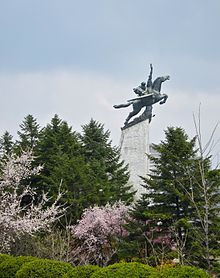The Chollima Statue (Korean: 천리마동상) is a monument on Mansu Hill in Pyongyang, the capital of North Korea. The monument symbolizes the "Chollima speed" of the Chollima Movement. The legendary winged horse Chollima depicted by the monument is said to travel 1,000 ri (400 km) a day.[1]
 The statue in 2010 | |
 | |
| 39°2′3.5″N 125°45′10.5″E / 39.034306°N 125.752917°E | |
| Location | Pyongyang, North Korea |
|---|---|
| Material | Granite and bronze |
| Height | 46 m (151 ft) |
| Opening date | 15 April 1961 |
| Dedicated to | Chollima Movement |
| Chollima Statue | |
| Chosŏn'gŭl | 천리마동상[1] |
|---|---|
| Hancha | 千里馬銅像[1] |
| Revised Romanization | Cheonrimadongsang |
| McCune–Reischauer | Ch'ŏllima Dongsang |
History
editThe monument was constructed as a gift to Kim Il Sung.[2] It was built by the Merited Sculpture Production Company of the Mansudae Art Studio.[3] The statue was unveiled on 15 April 1961, the 49th birthday of Kim Il Sung.[1] The impetus to build the monument was Kim Il Sung's speech "Let Us Further Develop Popular Art" given to rural amateur artist groups on 7 March 1961.[4][1] The Chollima Statue was awarded the People's Prize.[5]
Features
editThe monument is 46 meters tall in total. The sculpture stands 14 meters high and is 16 meters long. The two figures riding the Chollima, a male worker and a woman peasant, are 7 meters and 6.5 meters tall, respectively.[1] The worker raises the "Red Letter" of the Central Committee of the Workers' Party of Korea, and the peasant holds a sheaf of rice.[6][7] The figures are made of bronze, while the base is granite.[5]
See also
editReferences
edit- ^ a b c d e f Corfield, Justin (1 December 2014). Historical Dictionary of Pyongyang. London/New York: Anthem Press. pp. 32–33. ISBN 978-1-78308-341-1.
- ^ "Nordkorea-Bildband: Verboten schön" [North Korea Image Gallery: Forbidden Beauty]. Spiegel Online (in German). 15 June 2011. p. 11. Retrieved 15 October 2015.
- ^ Kim Kyong-hui (March 2013). "Prestigious Sculpture Production Company". Democratic People's Republic of Korea. No. 687. p. 21. ISSN 1727-9208.
- ^ Kim Il-sung (1983). Kim Il Sung: Works. Pyongyang: Foreign Languages Publishing House. p. 42.
- ^ a b "Chollima Statue, Symbol of Juche Korea". KCNA. 15 April 2006. Archived from the original on 12 October 2014. Retrieved 7 October 2015.
- ^ Chollima Statue. Naenara. Pyongyang: Foreign Languages Publishing House. n.d. Event occurs at 1:00. Retrieved 13 February 2016.
- ^ Pyongyang's Monuments and Architecture Archived 2018-03-23 at the Wayback Machine.
Further reading
edit- Meuser, Philipp, ed. (2011). Architekturführer Pjöngjang (in German). Berlin: DOM publishers. ISBN 978-3-86922-126-7.